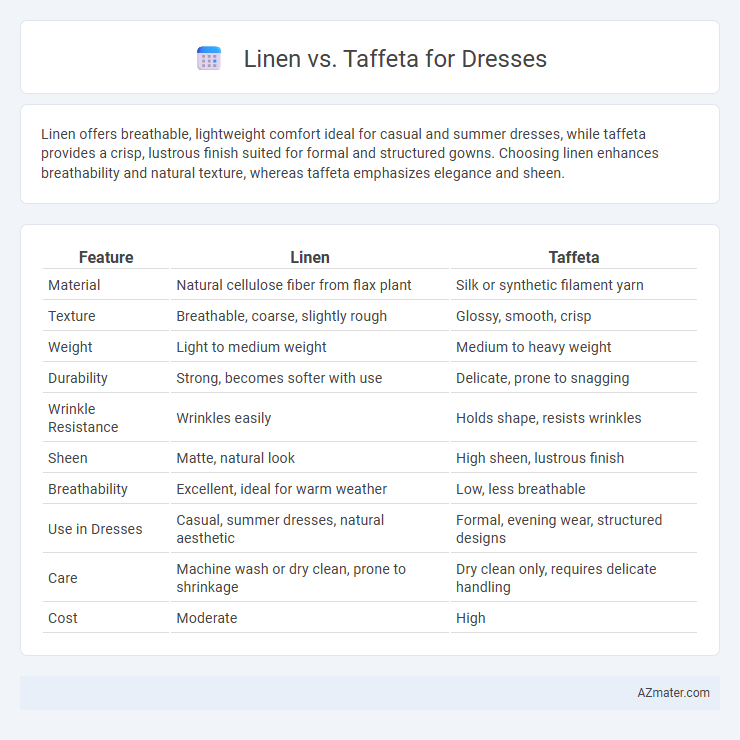Linen offers breathable, lightweight comfort ideal for casual and summer dresses, while taffeta provides a crisp, lustrous finish suited for formal and structured gowns. Choosing linen enhances breathability and natural texture, whereas taffeta emphasizes elegance and sheen.
Table of Comparison
| Feature | Linen | Taffeta |
|---|---|---|
| Material | Natural cellulose fiber from flax plant | Silk or synthetic filament yarn |
| Texture | Breathable, coarse, slightly rough | Glossy, smooth, crisp |
| Weight | Light to medium weight | Medium to heavy weight |
| Durability | Strong, becomes softer with use | Delicate, prone to snagging |
| Wrinkle Resistance | Wrinkles easily | Holds shape, resists wrinkles |
| Sheen | Matte, natural look | High sheen, lustrous finish |
| Breathability | Excellent, ideal for warm weather | Low, less breathable |
| Use in Dresses | Casual, summer dresses, natural aesthetic | Formal, evening wear, structured designs |
| Care | Machine wash or dry clean, prone to shrinkage | Dry clean only, requires delicate handling |
| Cost | Moderate | High |
Introduction to Linen and Taffeta
Linen is a breathable, natural fiber made from flax plants, prized for its lightweight texture and moisture-wicking properties, making it ideal for warm-weather dresses. Taffeta, a crisp, smooth fabric typically woven from silk or synthetic fibers, offers a luxurious sheen and structured form perfect for formal attire. Choosing between linen and taffeta depends on the desired comfort, durability, and dress style, with linen favored for casual wear and taffeta for elegance and volume.
Fabric Origin and History
Linen, derived from the flax plant, traces its origins to ancient Egypt and was prized for its breathability and durability in warm climates. Taffeta, originally made from silk and originating in Persia and later popularized in Europe during the Renaissance, is known for its crisp texture and lustrous finish. Both fabrics carry rich histories that influence their distinct uses in dressmaking, with linen favored for casual, breathable garments and taffeta chosen for formal, structured attire.
Texture and Appearance Comparison
Linen features a natural, slightly coarse texture with visible slubs that create a relaxed, breathable fabric ideal for casual or summer dresses. Taffeta displays a smooth, crisp surface with a subtle sheen, offering a structured and elegant appearance often used for formal gowns. The distinct tactile qualities and visual finishes of linen and taffeta cater to different dress styles, balancing comfort against sophistication.
Breathability and Comfort
Linen offers superior breathability and moisture-wicking properties, making it ideal for warm climates and ensuring comfort during extended wear. Taffeta, being a tightly woven silk or synthetic fabric, provides a smooth finish but tends to trap heat and offers less ventilation. For dresses prioritizing coolness and ease of movement, linen is the optimal choice, while taffeta suits more structured, formal designs where breathability is less critical.
Durability and Wearability
Linen offers excellent breathability and natural moisture-wicking properties, making it highly wearable for warm weather but prone to wrinkles and less durable due to fiber weakening over time. Taffeta, composed of tightly woven silk or synthetic fibers, provides superior durability with a smooth, crisp finish that resists wrinkles and maintains shape, ideal for structured dresses and formal wear. Despite its durability, taffeta can be less breathable and less comfortable for extended wear compared to the lightweight, airy nature of linen.
Suitability for Different Dress Styles
Linen offers a lightweight, breathable texture ideal for casual and summer dresses, providing a relaxed yet elegant drape that suits A-line, shift, and bohemian styles. Taffeta's crisp, smooth surface delivers structure and sheen, enhancing formal and evening wear such as ball gowns, mermaid dresses, and tailored cocktail dresses. The choice between linen and taffeta depends on desired dress silhouette, occasion, and fabric stiffness, with linen favoring comfort in warm climates and taffeta emphasizing sophistication and volume.
Maintenance and Care Requirements
Linen requires frequent ironing due to its natural tendency to wrinkle and should be hand-washed or dry-cleaned to maintain its texture and prevent shrinkage. Taffeta demands gentle dry cleaning to preserve its crisp structure and avoid damage from water or heat. Proper storage for both fabrics involves keeping them in a cool, dry place to prevent fabric deterioration and maintain the dress's overall appearance.
Color and Design Versatility
Linen offers a natural matte finish with muted, earthy tones that enhance breathable, casual dress designs ideal for summer wear. Taffeta features a lustrous sheen with vibrant, rich colors that create structured, elegant silhouettes often chosen for formal dresses and evening gowns. The color saturation and fabric stiffness in taffeta provide greater design versatility for dramatic shapes, while linen's texture suits relaxed, minimalist aesthetics.
Price and Availability
Linen dresses generally come at a moderate price point due to the natural fibers and breathable qualities, making them widely available in casual and summer collections. Taffeta, often used in formalwear, tends to be more expensive because of its luxurious sheen and structured texture, with availability primarily concentrated in specialty or designer stores. Both fabrics fluctuate in price and stock based on regional demand and seasonal trends.
Choosing the Right Fabric for Your Dress
Linen offers breathability, natural texture, and a casual elegance, making it ideal for warm weather and relaxed dress styles. Taffeta provides a crisp, smooth finish with a slight sheen, perfect for structured, formal dresses that require body and shape retention. Selecting between linen and taffeta depends on the dress's purpose, season, and desired silhouette, balancing comfort with formality.

Infographic: Linen vs Taffeta for Dress
 azmater.com
azmater.com